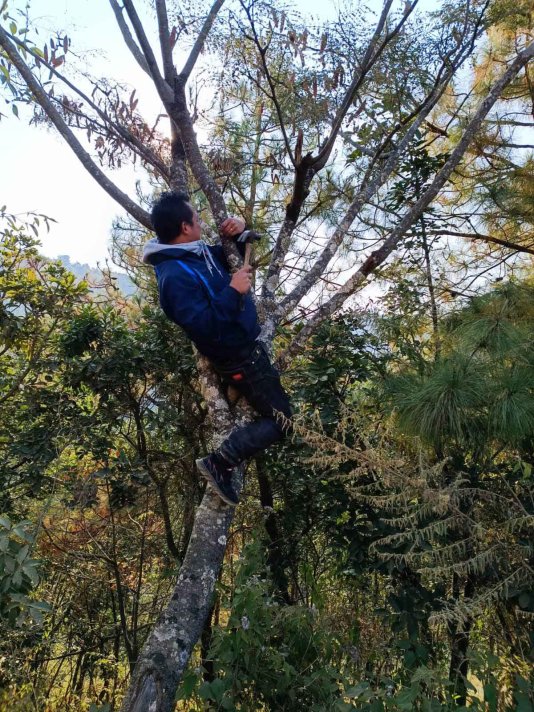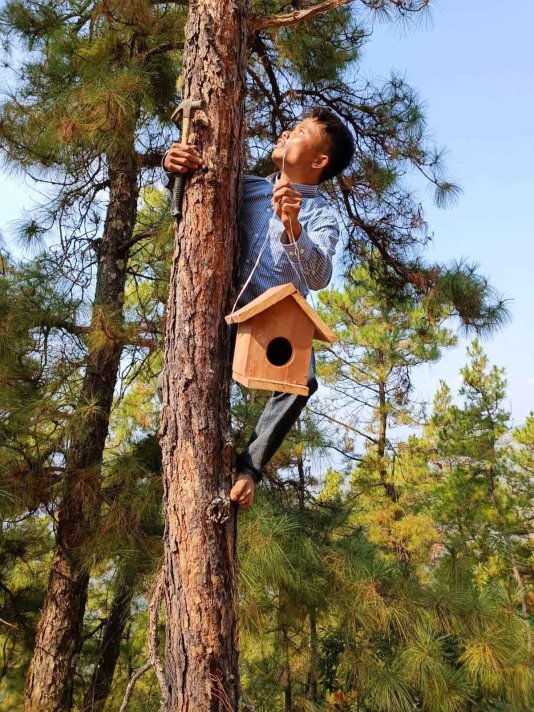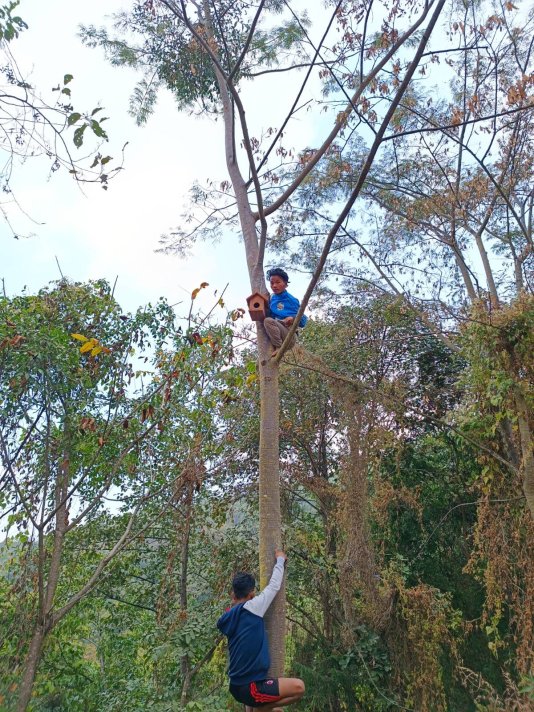- About
- Topics
- Picks
- Audio
- Story
- In-Depth
- Opinion
- News
- Donate
- Signup for our newsletterOur Editors' Best Picks.Send
Read, Debate: Engage.
| February 27, 2023 | |
|---|---|
| topic: | Conservation |
| tags: | #Myanmar, #birds, #conservation, #junta |
| located: | Myanmar |
| by: | Cha Pann |
U Salai Aung Myint (45), a native of the Chin Hills mountain range in northwestern Myanmar, has been taking action to save his home state’s feathered friends: great hornbills, a symbol of the Chin people, and the white-browed bluebird, a Myanmar-endemic bird species.
Once rich with Rhododendron and Cherry trees, the state's ecosystem has been partially devastated by the ongoing battles between pro-democracy protesters and military junta soldiers, which erupted following the February 2021 coup that saw the toppling of elected-leader and Nobel Peace Prize laureate Aung San Suu Kyi.
The first armed resistance by civilians against the junta was sparked by Chin State residents with traditional handmade rifles known as Tumee. In response, military forces burned down houses, tortured villagers and displaced more people in Chin State. This has largely disrupted local bird conservation efforts.
According to ornithologist and bird conservationist U Thet Zaw Naing, Chin State houses 549 different bird species.
"The white-browed bluebird, a Myanmar-endemic bird species that needs global conservation, is one of more than 100 rare bird species in Chin State," U Thet told FairPlanet. "There is an urgent need to preserve and protect Blyth's Tragopan and Aung Lang (great hornbill), which are symbols of the Chin people."
He added that Chin State is one of the top destinations for birdwatchers, both local and tourists, and is highly sought after by those who have yet to visit.
Now, native birds in the area face numerous threats, and U Thet said the they are routinely captured and killed through a number of methods. This, along with habitat destruction, is leading to their extinction.
Efforts to conserve the local bird populations are hampered by political instability, according to the bird conservationist. Myanmar, he said, has never been an easy place for birds to survive, but now it's at its worst.
U Salai Aung Myint, a Chin State resident, figured out a way to help support local bird populations, and planned to hang hundreds of birdhouses on trees in the area in order to raise awareness among villagers about the decline of birds as a result of hunting and habitat destruction.
In spite of the raging battles, U Salai has managed to hang 200 birdhouses as of this reporting with the help of local villagers. The birdhouses were hung from trees along the Kalay-Falam-Hakha and Kalay-Theinni-Tedim-Tonzang roads before a forest fire broke out between December 2022 and January 2023.
He came up with this idea while being a student in Singapore in 2015. There, U Salai learned that the Singaporean government had built a man-made bird nests that simulated a nest in the wild in order to encourage native birds to return.
The project was funded by donations from U Salai's close friends, who contributed a total sum of K1400,000 (USD 666).
"I have had this idea for some time," U Salai told FairPlanet. "Even if I hang birdhouses from trees, no birds will come to live in them. Wild birds don't live in birdhouses. But birdhouses may remind passers-by about how birds are disappearing from sight."
Conservationist U Thet further said that a birdhouse needs to be built in a particular way in order to successfully attract birds. "Only if people are able to build a birdhouse that mimics a nest of its species, it will attract the species to the birdhouse."
He added that the building method of a birdhouse differs depending on the species it looks to cater. If one intends to build a house for a sparrow, for instance, it has to simulate its particular type of nest.
"In countries that lack trees used by cavity-nesting birds, people build birdhouses that simulate their nests," U Thet said. "But in Myanmar the situation is not that bad for cavity nesters."
He added, however, that birdhouses nonetheless help increase the sizeof bird populations.
"Birdhouses are helpful for the great hornbills to have offspring," he said. "In later years, the number of the great hornbills has increased, thanks to birdhouses."
The day after Christmas, U Salai's friends and a group of volunteers began hanging wooden birdhouses on various types of trees with large branches around the towns of Tedim and Falam.
Locals in the area have had different reactions to the birdhouses.
"Some are amazed that a need for birdhouses even appears, while others worry that birdhouses would be stolen, and some wonder if we would put birds in the birdhouses," Ko Mungno, who has helped hang birdhouses in the vicinity of Tedim, the second largest town in Chin State, told FairPlanet.
The team is now looking to hang birdhouses in 10 villages around Tedim, where children often shoot small birds with catapults, while bird hunters use Tumee (handmade rifles) to hunt birds.
"We haven't seen our Chin people's symbol, the great Hornbills, in a long time," Ko said. "We see only small birds in the area around Tedim."
During the day, junta troops travel along the same roads he uses to go and hang birdhouses. He said he and his fellow volunteers must be extremely careful, as they do not want their birdhouses to be mistaken as bombs.
"We are very cautious when hanging birdhouses from trees. We are afraid to be tracked by the junta soldiers," Ko said.
Now that 200 wooden birdhouses have been installed, U Salai intends to build and hang an additional 500 to 1,000 birdhouses at other locations across the nation. He said he wants to earn a Guiness World Record for his efforts.
"I love my native environment," U Salai concluded. "I am happy to have realised my dream. Other places in Myanmar have already contacted me. Such an initiative is unusual in Myanmar.
"I hope this will inspire people to take action and encourage them to get involved. I hope it spreads across the country."
Image by C S Mung No
By copying the embed code below, you agree to adhere to our republishing guidelines.


